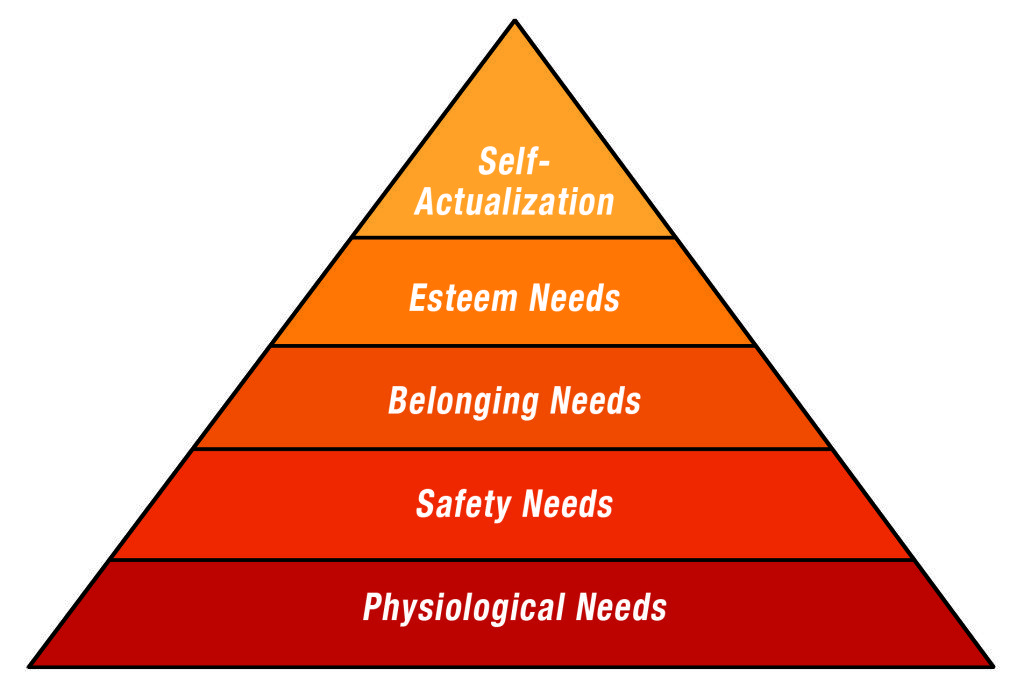
Abraham Maslow postulated that humans have an ascending order of needs and used a hierarchal pyramid to prioritize them. At the bottom levels of the pyramid are our physiological needs—like food, shelter, and clothing—that we need to survive. As these needs are met, progressively higher needs present themselves: safety and security, social interaction, and self-esteem, all topped by self-actualization, a term Maslow used to describe the ultimate human need to learn, grow, and reach one’s full potential.
Physiological Needs
These needs can be divided into two categories:
1.The first category is made up of needs that are homeostatic—the need to maintain an internal, biological balance—and include such things as salt concentration, sugar concentration, and water concentration in the blood. If a substance is out of balance, there will be a desire to consume foods that bring these levels back into balance.
2.The second category includes those needs that are not homeostatic, such as sleep and sex.
Both of these categories are deeply rooted in the biological systems of the body. More importantly, if one were to strip a person of material possessions and psychological identity, physiological needs would be the primary driver of that person’s behavior. All actions would be directed at satisfying basic needs, and the person would seek an environment to satisfy these needs. Near a large bike rally, Wal-Mart noticed that for temperatures above 88 degrees, beer sales went down and water sales went up.
In modern societies, it is rare for anyone to experience this level of physiological-driven motivation. It would be even rarer to find an individual who is completely dissatisfied for an extended duration of time.
Safety Needs
Once physiological needs are satisfied, safety needs emerge. These include the need for security and stability. If you were to strip someone of everything but his or her physiological needs, safety needs would become the primary motivator, but not with the same sense of urgency as physiological needs.
As with physiological needs, modern society ensures that safety needs are sufficiently satisfied for the vast majority of adults. Safety needs occur on smaller scales and are seen in people’s desires for certainty: job stability and insurance policies—a general preference for the known over the unknown.
Belongingness and Love Needs
When physiological and safety needs are met, belonging needs emerge. These include the need for affection, relationships, and belongingness, as to a group. In daily life, people exhibit these needs in their desire to marry, have a family, be a part of a community, a member of a church, a brother in a fraternity, a member of a gang, or a member of a bowling club. Belonging is also a part of what they look for in a career.
It is at this level that the support and social structure of modern society becomes insufficient to fulfill a person’s needs. Modern society shows its fragmentation in the breakdown of traditional groups. Increased mobility has left many feeling disconnected and unfulfilled. The importance of neighborhoods and families to an individual’s well-being has been overlooked. Moreover, there’s no indication this fragmentation is going to slow down. Maslow cited these unmet needs as being the primary cause for mental disorders. He commented, “We have largely forgotten our deep animal tendencies to herd, to flock, to join, to belong.” This need reveals why consumers choose to be part of brands that offer them connection and belonging, such as Jimmy Buffett’s Parrotheads or Harley-Davidson’s H.O.G.
Esteem Needs
Maslow divided the next level in the hierarchy into two categories: the need for esteem from others and the need for self-esteem. The need for esteem from others is met externally and includes the desire for status and dominance, while the need for self-esteem is met internally and includes the want of independence and mastery.
Maslow believed the healthiest way to satisfy esteem needs was to have both internal and external esteem needs met as a result of a person’s authentic nature, so that any respect gained would be merited rather than derived from the presentation of a false self.
Self-Actualization
At the top of the hierarchy is the need for self-actualization. By this, Maslow meant the need to be what one has the potential to become. In Motivation and Personality, Maslow wrote, “Musicians must make music, artists must paint, poets must write if they are ultimately to be at peace with themselves. What humans can be they must be. They must be true to their own nature. This need we may call self-actualization … It refers to people’s desire for self-fulfillment, namely, the tendency for them to become actualized in what they are potentially.”
At this level, the needs lower in the hierarchy are satisfied, and, therefore, cease to motivate the individual. However, the need for self-actualization cannot be satisfied, and any satisfaction that is gained only serves to further motivate the individual.
